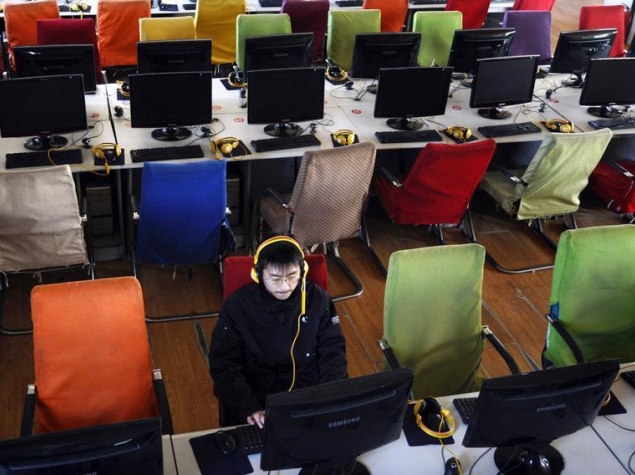- Home
- Internet
- Internet News
- Cybercrime fuelling a mature, sophisticated online economy: Study
Cybercrime fuelling a mature, sophisticated online economy: Study

A study by Rand Corp. and commissioned by the security firm Juniper Networks found a well-organized, multi billion-dollar underground economy that has become "a playground of financially driven, highly organized and sophisticated groups."
The evolution of cybercrime creates new challenges for security professionals trying to protect computer networks, says Nawaf Bitar, Juniper's general manager for security.
"We have long suspected that cybercriminals were sophisticated and that they had an organizational structure, but no one had studied this," Bitar told AFP.
"The success of this market is driven by accelerated economics, and the way to address this is through economics."
The report says the black markets "are growing in size and complexity" and that this activity "mirrors the normal evolution of a free market, with both innovation and growth."
Juniper's security vice president Michael Callahan said this cyber-underground has all the characteristics of an economy, including its own currencies chiefly cryptographic payment forms such as Bitcoin.
Callahan said the underground economy is characterized by specialization and "resilience," so that if one market participant leaves, another steps up.
"We saw this when (the black market bazaar) Silk Road went down, and within a day other participants started filling that gap," Callahan said.
"It's one of those signs this is a mature economy."
'Honour among thieves'
The report notes that, just as in some organized crime groups, there is a code of conduct that helps reassure customers.
"You have honour among thieves," Callahan said.
"They work to a level of conduct. They know it is in all of their best interests to follow the rules. Like in other markets, these people know that your reputation is key."
The report suggests that about 30 percent of the sellers of financial data are "rippers," who fail to deliver promised goods or services.
These abuses generally occur in the "lower" levels of the black market that are easiest to access. But these rippers "tend to get reported and then often quickly removed," the report said.
The study found these markets span the globe from China to Eastern Europe to Latin America, with many US-based players and "more cross-pollination between these cybercriminals than ever before."
The cybercrime world features "storefronts" like other forms of e-commerce, with hacker tools and services bought and sold.
The tools available include those used in the attack on US retail giant Target, where upwards of 110 million customers may have had their personal data stolen.
For those who lack technical savvy, new services are offered. Rand found one can obtain a Distributed Denial of Service (DDoS) attack in which hackers overwhelm a server to interrupt access for as low as $50 for a 24-hour attack.
'Active resistance'
Bitar said the cyber-security community needs to shift its focus because of the new threat, because the traditional methods of using firewalls and other defensive measures are not enough.
"We need to use active resistance rather than passive resistance," he said.
This could involve setting traps, using encryption and delivering bogus information that disrupts efforts by hackers and attacks.
But he said he strongly opposes the idea of "hacking back" at the attackers.
"I believe that is wrong. You can harm innocent bystanders," he said.
Catch the latest from the Consumer Electronics Show on Gadgets 360, at our CES 2026 hub.
Related Stories
- Samsung Galaxy Unpacked 2025
- ChatGPT
- Redmi Note 14 Pro+
- iPhone 16
- Apple Vision Pro
- Oneplus 12
- OnePlus Nord CE 3 Lite 5G
- iPhone 13
- Xiaomi 14 Pro
- Oppo Find N3
- Tecno Spark Go (2023)
- Realme V30
- Best Phones Under 25000
- Samsung Galaxy S24 Series
- Cryptocurrency
- iQoo 12
- Samsung Galaxy S24 Ultra
- Giottus
- Samsung Galaxy Z Flip 5
- Apple 'Scary Fast'
- Housefull 5
- GoPro Hero 12 Black Review
- Invincible Season 2
- JioGlass
- HD Ready TV
- Laptop Under 50000
- Smartwatch Under 10000
- Latest Mobile Phones
- Compare Phones
- OPPO Reno 15 Pro Max
- Honor Win RT
- Honor Win
- Xiaomi 17 Ultra Leica Edition
- Xiaomi 17 Ultra
- Huawei Nova 15
- Huawei Nova 15 Pro
- Huawei Nova 15 Ultra
- Asus ProArt P16
- MacBook Pro 14-inch (M5, 2025)
- OPPO Pad Air 5
- Huawei MatePad 11.5 (2026)
- Xiaomi Watch 5
- Huawei Watch 10th Anniversary Edition
- Acerpure Nitro Z Series 100-inch QLED TV
- Samsung 43 Inch LED Ultra HD (4K) Smart TV (UA43UE81AFULXL)
- Asus ROG Ally
- Nintendo Switch Lite
- Haier 1.6 Ton 5 Star Inverter Split AC (HSU19G-MZAID5BN-INV)
- Haier 1.6 Ton 5 Star Inverter Split AC (HSU19G-MZAIM5BN-INV)

















